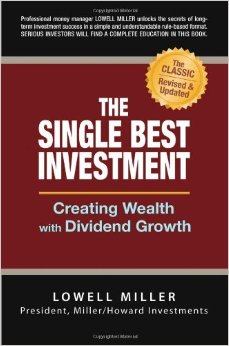The Single Best Investment: Creating Wealth with Dividend Growth, is the title of a classic investment book first published in 2006 by Lowell Miller, who heads Miller/Howard Investments.
It came to my attention via Wes Moss, who I interviewed for an upcoming MoneySense column, whose book You Can Retire Sooner Than You Think we reviewed here at the Hub. I mentioned the book in passing last week in this MoneySense blog last week. That blog focused on asset allocation but provided a big hint about Miller’s philosophy: there’s no place for bonds in Lowell’s investment worldview.
The book’s first chapter sets the tone in its title: Say goodbye to bonds and hello to bouncing principal. Like many stock believers and bond haters, Miller takes it as a given that the investing environment generally includes inflation. Since “safe” investments like t-bills, bonds, money market mutual funds and CDs (Certificates of Deposits in his native USA; known as GICs in Canada) are all “poor investments because what they give is less than inflation takes away.”
Stocks are the only asset class likely to beat inflation in the long run, but the “price” of such an investment is volatility. Miller advocates creating a portfolio of about 30 quality dividend-paying stocks with a record of raising dividends, then letting time work its compounding magic. This portfolios becomes “your own private compounding machine.” (As an aside, these days you can find a number of ETFs that hold so-called Dividend Aristocrats that accomplishes much the same thing, but Miller doesn’t go there, at least in the early edition of the book I reviewed.)
Formula for success
Miller’s formula is outlined in chapter 4 : High Quality + High Current Dividend + High Growth of Dividend = High Total Returns.
When it comes to dividend yield, he advocates shooting for twice the current market average, and a minimum 150% of average. Growth of Yield must at least keep pace with inflation.
Miller challenges the notion of undervaluation, saying “those who assert ‘undervaluation’ are either arrogant or uncomprehending. Information is everywhere; how could a stock be undervalued?” The idea of value usually means a narrative, imagining what may happen in the future. The “story of of the stock” should include reliable and repeating sales with moderate increases, plus some kind of growth kicker.
Equal dollar weighting
As noted earlier, Miller is not a fan of traditional asset allocation, insisting that a portfolio of 30 “Single Best Investment” stocks is intended to replace asset allocation or the usual “Balanced” portfolio — “without the performance drag of fixed income.” Diversify across sectors with roughly 30 holdings held in equal dollar amounts. (so-called Equal Weighting). Portfolios can be tilted toward higher income if necessary for current spending.
Typical categories
The book includes a useful appendix that lists the major categories of “Single Best Investment Stocks.” They include often-overlooked Utilities, REITs, Banks, Oil & Gas, Insurance, Service Companies, Industrial Services, Food and Defensive Companies, and Cyclicals & Commodity-based stocks.


